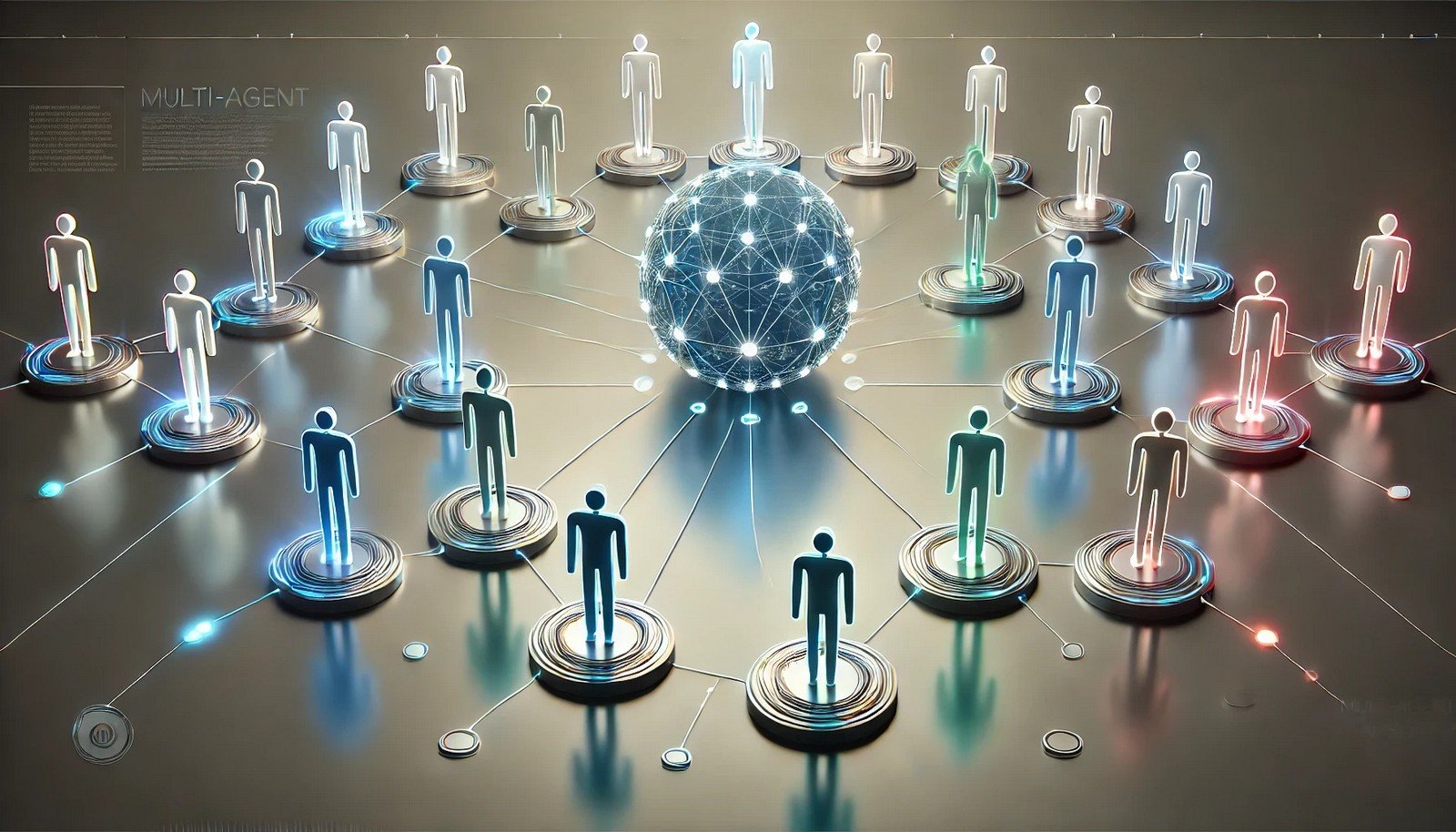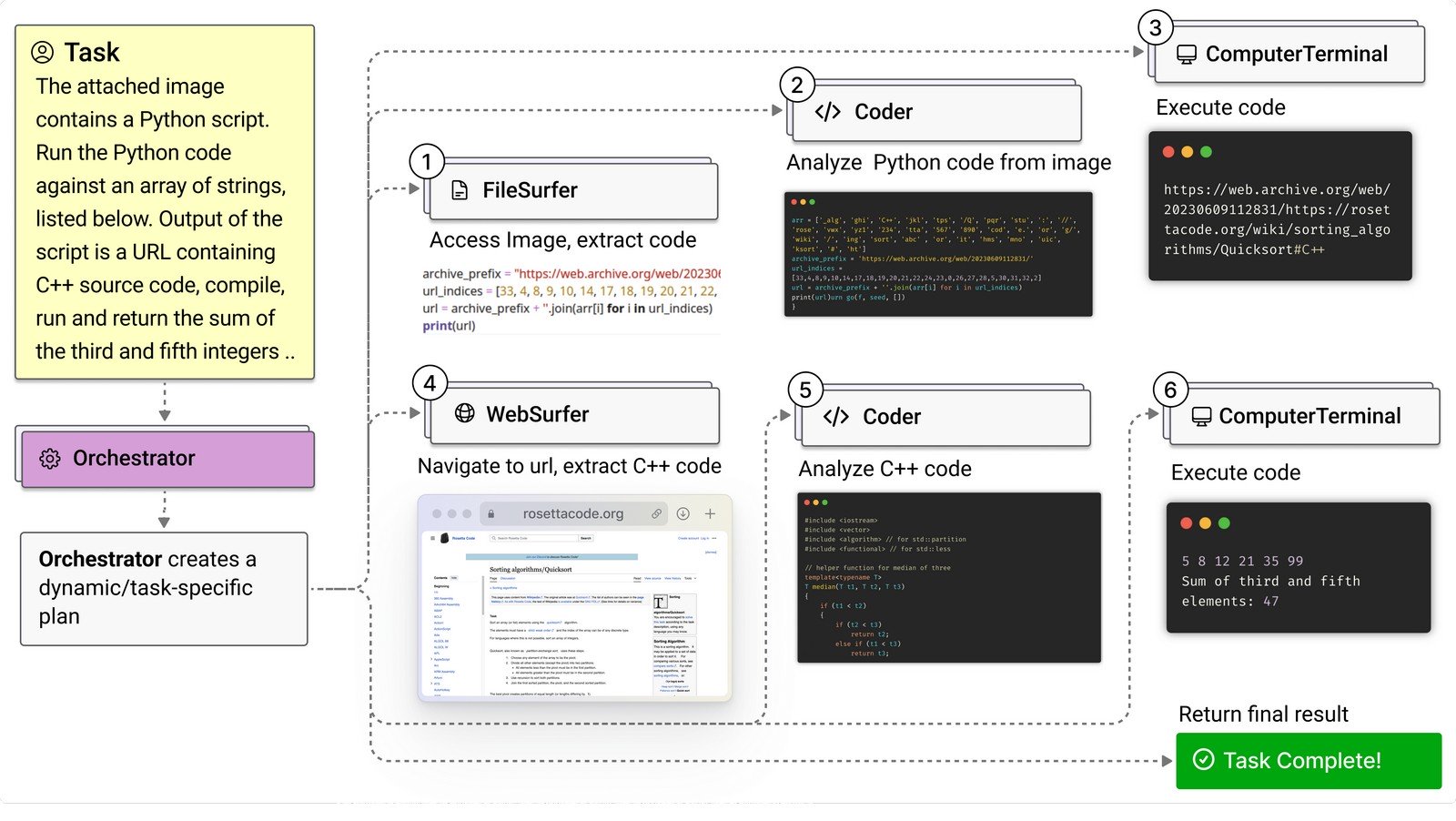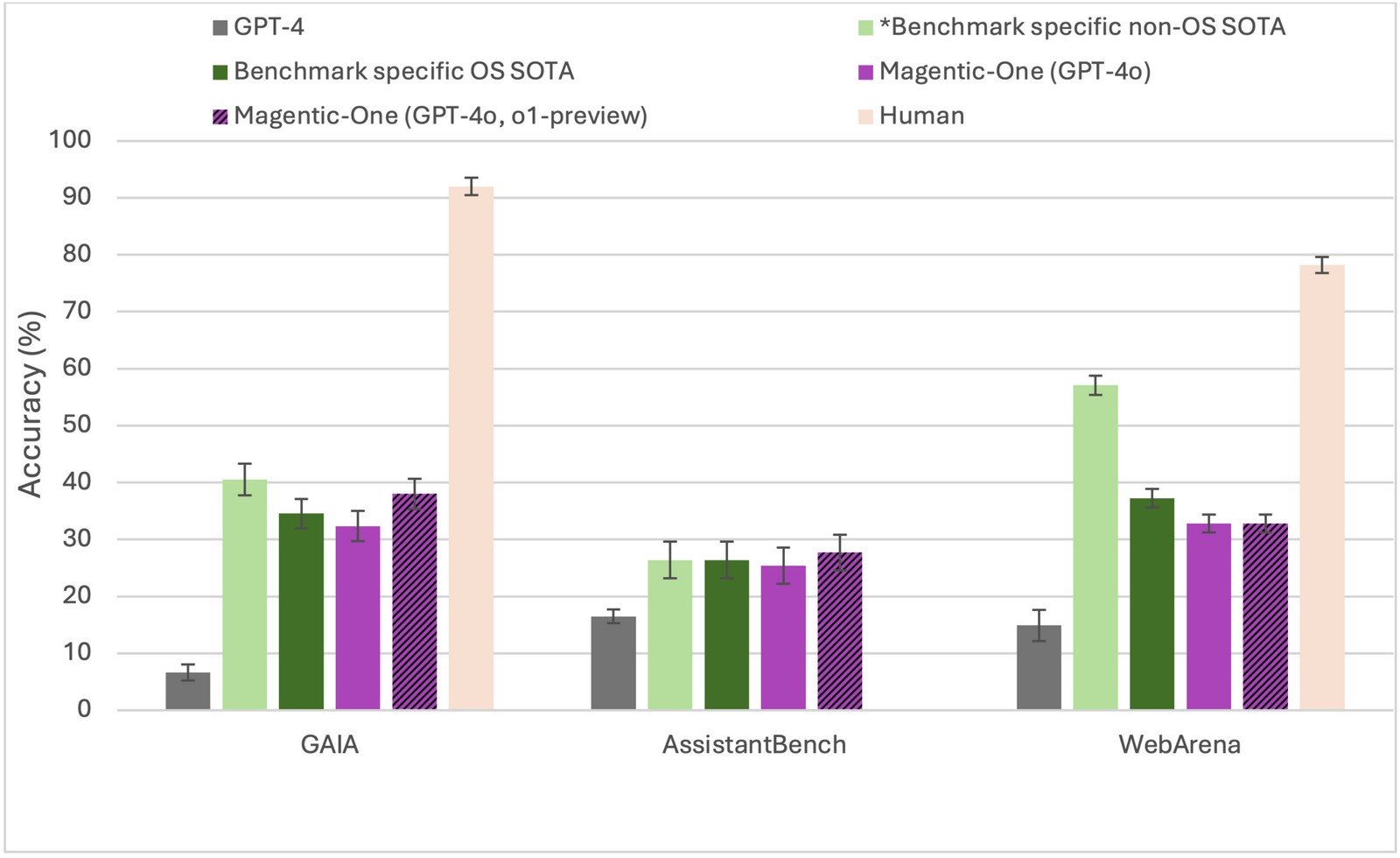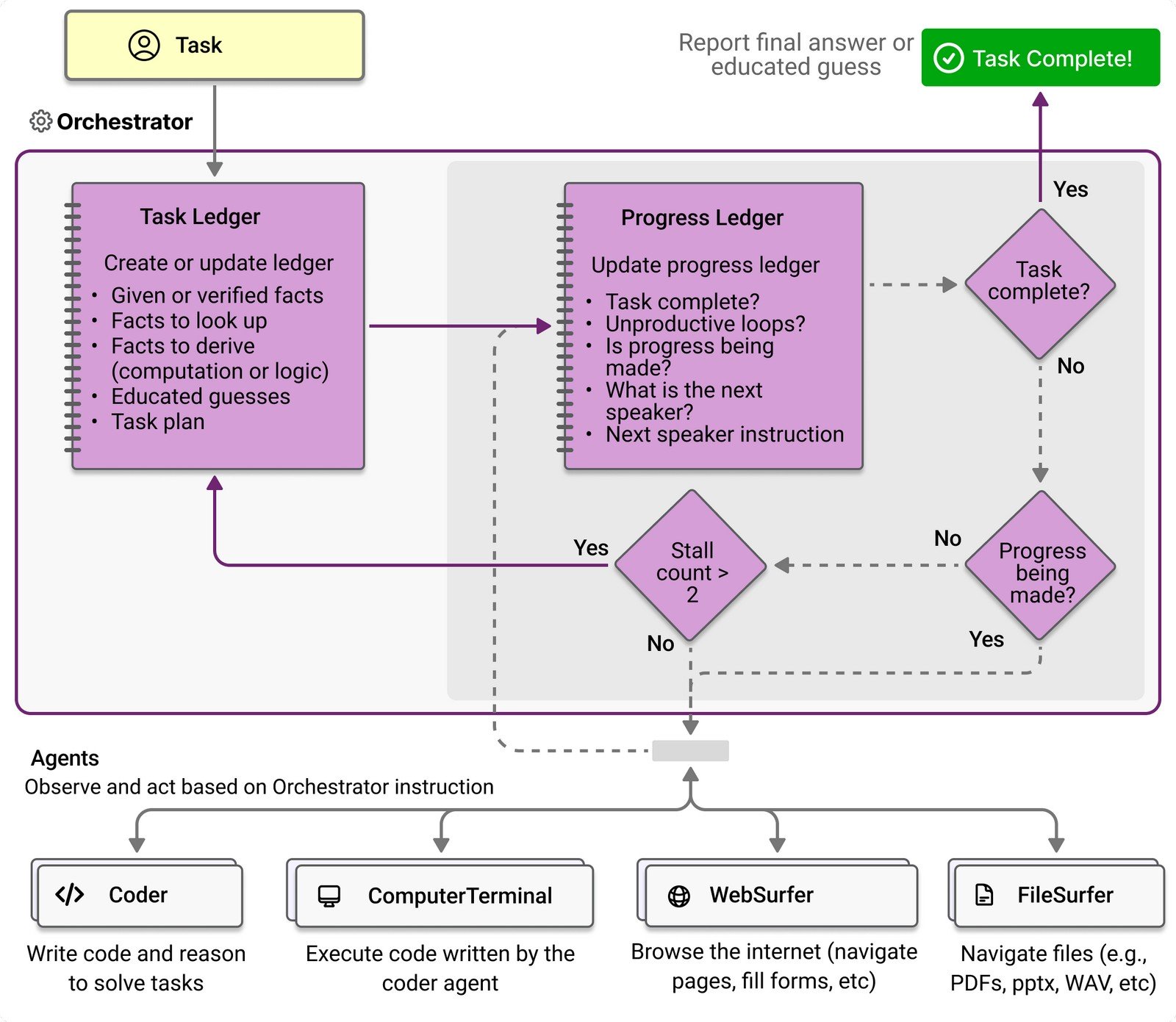FAQ: Magentic-One and Agentic AI Systems 
Quick Navigation:
- What is Magentic-One?
- How does Magentic-One's architecture work?
- What are the components of Magentic-One?
- What benchmarks have tested Magentic-One?
- How do I install and set up Magentic-One?
- What makes Magentic-One modular?
- How does the Orchestrator ensure task success?
- What precautions should developers take when using Magentic-One?
- What are the risks of using agentic AI like Magentic-One?
- How does Magentic-One perform compared to single-agent systems?
- What safety mechanisms are built into Magentic-One?
- What are AutoGenBench's features, and how does it relate to Magentic-One?
- What deployment options are available for Magentic-One?
- How does Magentic-One adapt to errors during execution?
- What use cases are ideal for Magentic-One?
- What frameworks are similar to Magentic-One?
- How does Magentic-One address safety challenges in AI?
- How is Magentic-One contributing to AI advancement?
- Where can I learn more about Magentic-One?
What is Magentic-One?
Magentic-One is an open-source, generalist multi-agent system designed by Microsoft Research. It uses a multi-agent architecture to solve complex tasks across domains like software engineering, web browsing, and data analysis. Learn more about the Magentic-One system.
How does Magentic-One's architecture work?
Magentic-One's architecture features an Orchestrator agent that coordinates specialized agents, including WebSurfer, FileSurfer, Coder, and ComputerTerminal. This modular approach allows agents to execute subtasks autonomously while the Orchestrator manages the overarching task plan. Explore its architecture via the official documentation.
What are the components of Magentic-One?
The key components are:
- Orchestrator: Manages planning, progress tracking, and re-planning.
- WebSurfer: Handles web interactions.
- FileSurfer: Manages file navigation and reading.
- Coder: Writes and executes code.
- ComputerTerminal: Provides shell access for executing commands and installing libraries.
Details on these components are available in the Magentic-One overview.
 (Credit: Microsoft.com)
(Credit: Microsoft.com)
What benchmarks have tested Magentic-One?
Magentic-One has been rigorously evaluated on GAIA, AssistantBench, and WebArena benchmarks. It achieved a 38% success rate on GAIA and a 32.8% completion rate on WebArena, demonstrating competitive performance compared to state-of-the-art systems. Evaluation details can be found in AutoGenBench.

Credit: Microsoft.com)
How do I install and set up Magentic-One?
Follow these steps to access and set up Magentic-One:
- Clone the repository:
git clone https://github.com/microsoft/autogen.git
- Navigate to the directory:
cd autogen/python/packages/autogen-magentic-one
- Install dependencies:
pip install -e .
- Install Playwright:
playwright install --with-deps chromium
- Run the example:
python examples/example.py --logs_dir ./my_logs
For more details, refer to the Magentic-One GitHub repository.
What makes Magentic-One modular?
Magentic-One's modular design allows developers to add or remove agents without altering the entire system. This adaptability ensures seamless scalability and simplifies system updates. Its modularity is detailed in the AutoGen framework documentation.
How does the Orchestrator ensure task success?
The Orchestrator manages a Task Ledger and Progress Ledger to monitor progress and detect errors. If progress stalls, it revises the task plan, ensuring efficient execution. This dynamic adjustment process is illustrated in the Magentic-One task flow.

(Credit: Microsoft.com)
What precautions should developers take when using Magentic-One?
To minimize risks:
- Use sandboxed environments like Docker.
- Monitor system logs for anomalies.
- Restrict sensitive data access and ensure human oversight during high-risk operations.
Best practices are highlighted in the safety guidelines.
What are the risks of using agentic AI like Magentic-One?
Magentic-One interacts with digital environments and may inadvertently take irreversible actions, such as deleting files or sending emails. Developers should implement strict controls and continuous monitoring, as outlined in Microsoft's Responsible AI principles.
How does Magentic-One perform compared to single-agent systems?
Unlike single-agent systems, Magentic-One employs specialized agents to handle subtasks in parallel. This improves scalability, fault tolerance, and efficiency in executing complex workflows. Learn more about its performance in the benchmarking report.
What safety mechanisms are built into Magentic-One?
Magentic-One incorporates pauses before performing high-risk actions, requiring human confirmation. Developers are advised to follow the least privilege principle and enable real-time oversight. Safety features are elaborated in the Magentic-One safety documentation.
What are AutoGenBench's features, and how does it relate to Magentic-One?
AutoGenBench is an evaluation tool for agentic systems. It allows controlled testing with repetition and isolation to ensure accurate benchmarks while minimizing side effects. Access AutoGenBench here.
What deployment options are available for Magentic-One?
Magentic-One can be deployed on:
- On-premises: For greater control over data and environment.
- Cloud: For scalability and remote access.
- Edge devices: Where computational capabilities are sufficient.
How does Magentic-One adapt to errors during execution?
If a task fails, the Orchestrator revises the Task Ledger and generates a new plan, ensuring resilience and adaptability. This ability to recover from errors is a core strength of Magentic-One's architecture.
What use cases are ideal for Magentic-One?
Ideal applications include:
- Automating business workflows.
- Conducting literature reviews.
- Debugging and generating software code.
Its versatility makes it suitable for dynamic, multi-step tasks.
What frameworks are similar to Magentic-One?
Comparable frameworks include:
- AutoGen: For agent collaboration.
- CrewAI: Specializes in role-based task execution.
- LangGraph: Facilitates multi-agent communication.
Explore AutoGen for details.
How does Magentic-One address safety challenges in AI?
Through rigorous red-teaming exercises and adherence to Responsible AI practices, Magentic-One proactively mitigates risks like prompt injection attacks and harmful content generation. Microsoft’s commitment to safety is outlined in the Responsible AI framework.
How is Magentic-One contributing to AI advancement?
By pioneering generalist agentic systems, Magentic-One bridges the gap between conversational and actionable AI, enabling autonomous task management. Its open-source nature invites community collaboration, fostering innovation in agentic systems.
Where can I learn more about Magentic-One?
Explore the Magentic-One GitHub repository for access to source code, setup guides, and example tasks. Detailed documentation and evaluation reports are also available through Microsoft's resources.
We made FaqGuru.com to simplify understanding through FAQs. If you have questions, please reach out to us on WhatsApp or Twitter.Authors | Arjun Vishnu | @ArjunAndVishnu

I am Vishnu. I like AI, Linux, Single Board Computers, and Cloud Computing. I create the web & video content, and I also write for popular websites.
My younger brother, Arjun handles image & video editing. Together, we run a YouTube Channel that's focused on reviewing gadgets and explaining technology.
Comments powered by CComment